Finding Our Place in the World

Conventionally, people tend to thing of maps as useful tools with which to physically orient ourselves within a landscape, yet in their recent book, Maps: Finding Our Place in the World, editors James A. Ackerman and Robert W. Karrow demonstrate that throughout the ages maps have had a much greater range of utility. The August edition of the The Art Book features a review of Maps that praises the editors for their insightful exploration of maps’ varying purposes—from maps that orient us geographically, to those that orient us historically and even culturally. From the Art Book:
[In Maps] essays by distinguished contributors break the boundaries of chronology and the limitations of conventional Western geography to consider instead a cluster of maps’ varying purposes.…
The extensive first essay, ‘Finding our way’ by Akerman (organiser of a splendid Newberry exhibition on American road maps), addresses most observers’ experiences of maps, i.e. as instructions for directed travel.… Allegorical pathways, clearly charted for religious or fantasy realms, are reserved for a fine later essay, ‘Imaginary worlds’, by Ricardo Padron. Another fascinating essay, on the conceptual or thematic use of maps (including geological or astronomical maps), often with statistical graphs to convey data, is provided by Michael Friendly and Gilles Palsky.… More particular maps of cities or regions, including property or military maps, are surveyed by Matthew Edney, who links their spatial uses to ‘expansive’ societies with expansive economic activity and social stratification. He notes that ‘social needs, power relations, and cultural conventions underpin the production and use of all maps’.…
Ultimately, Maps:Finding Our Place in the World shows clearly how interdisciplinary and visual the study of maps can be.
Read the article or see a collection of unusual maps from the book.